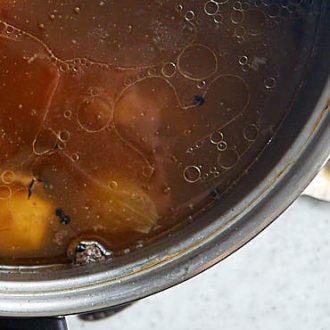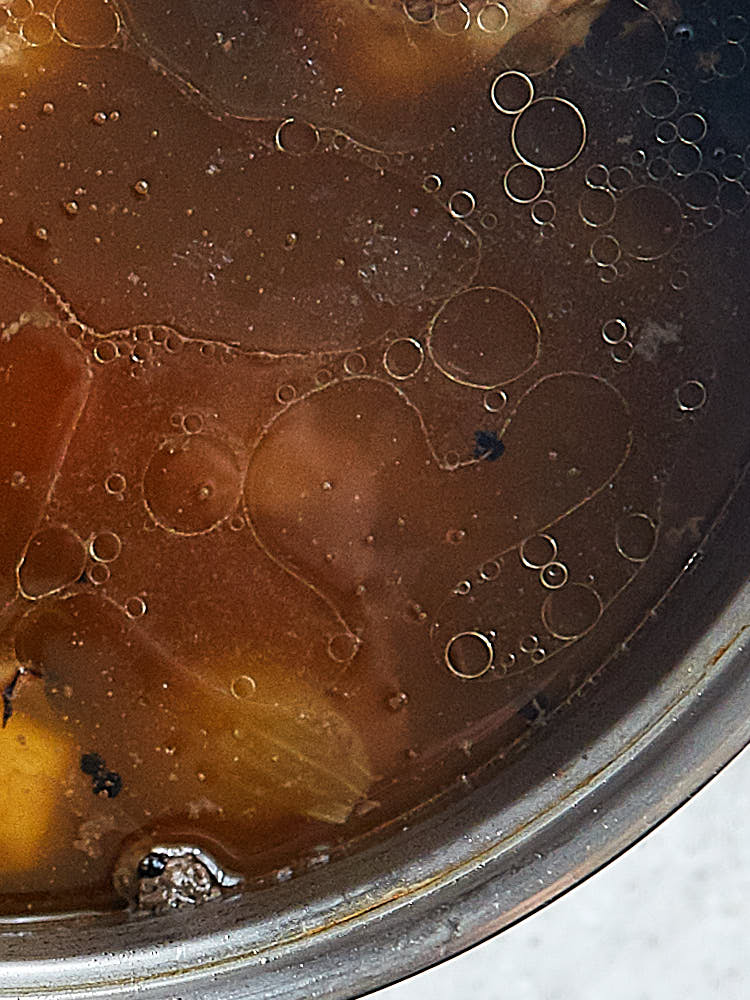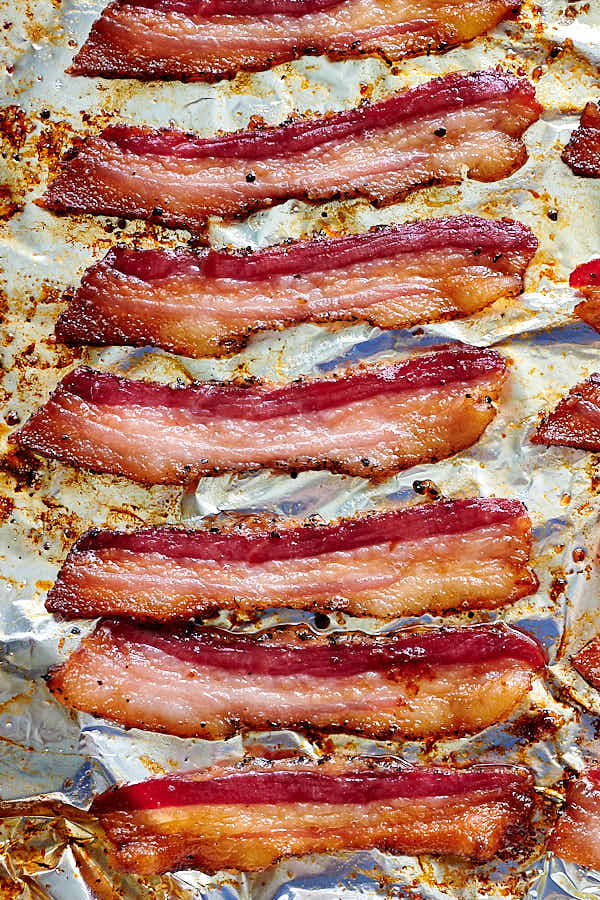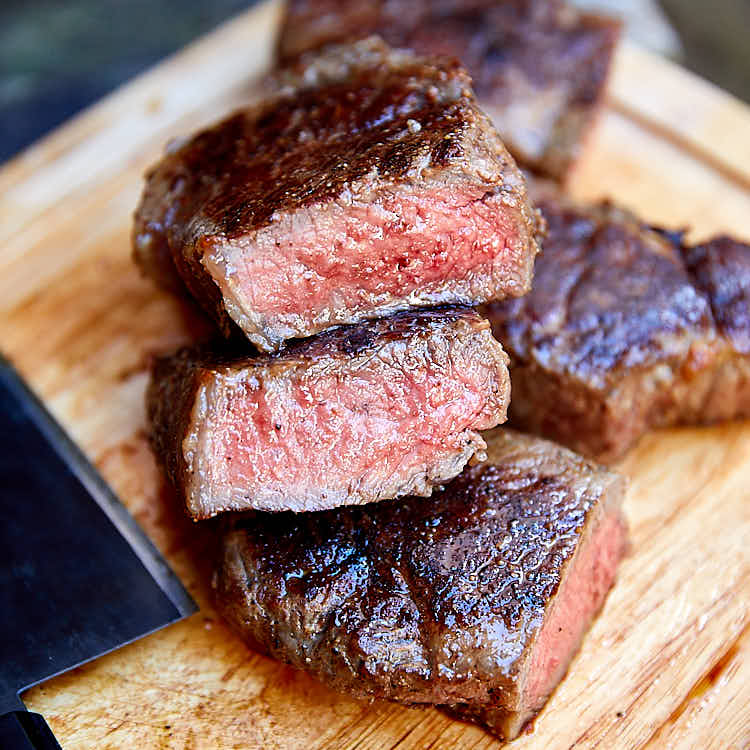What is the difference between beef stock and beef broth?
This is one of the most common questions asked by novice home cooks. Even some experienced cooks seem to use both terms interchangeably, but there is a simple distinction between the two. According to the traditional definition, beef broth is made by simmering meat a vegetables, while beef stock is made by simmering bones and vegetables. This tiny difference has a significant effect on the final product - a properly made beef stock will be thicker and richer in gelatin than a broth since gelatin is extracted from cartilage and connective tissues around bones.
A beef broth will have a more distinct beefy flavor from the meat. Traditionally, beef stock, due to its more neutral taste, is used as a base for many sauces and soups. A broth, on the other hand, is a great choice for soups or dishes that required a strong and distinct beef flavor.
Types of beef stock
Beef stock is typically divided into two categories: white beef stock and brown beef stock. White beef stock is made from beef or veal bones, or a combination of the two. Brown beef stock is made from beef and/or veal bones that have been browned in an oven or in a pan.
Beef stock ingredients
Bones
When certain connective tissues (called collagen) break down, they form gelatin. This gives a stock it's thick body, an important indication of a stocks's quality. A well-made stock thickens or even becomes solid when chilled. Cartilage is the best source of gelatin in bones. Younger animals have lots of cartilage in their skeletons. As they become older, this hardens into solid bone, which is harder to dissolve into stocks. Knuckle bones, on the joints of major bones, have a lot of
cartilage and are most often preferred for stock-making. Neck bones and shank bones are also often used. Large bones need to be cut into 3-4-inch pieces for better handling and better extraction.
Mirepoix
Aromatic vegetables are the second most important contributors of flavor to stocks, after bones and meat. Mirepoix today refers to a combination of onions, carrots, and celery. It is a basic flavoring in many areas of cooking and not only for flavoring stocks. The traditional mirepoix in the past would contain a wider variety of ingredients, including ham or bacon, leeks and other vegetables, and one or more fresh herbs. The modern version is considerably simplified but you should feel free to add more ingredients as desired.
A white mirepoix, in which parsnips are substituted for carrots, can be used when it is necessary to keep the stock as colorless as possible, usually when making white beef stock. When making white mirepoix, celery root can be substituted for the stalk celery for an even whiter mirepoix. It's also a good idea to include leeks in the mirepoix in place of part of the onions in a white mirepoix for their flavor.
Acidic ingredients
Acids help dissolve connective tissues and so are a great addition when making beef stock. Tomatos and tomato products contribute flavor and some acid to brown stocks, though in small quantities as they may make a stock cloudy. When making white beef stocks tomato products are not included due to their color.
Seasonings and spices
Salt is usually not added when making stocks. That's because stocks are often reduced, concentrated, and combined with other ingredients. If salt were added, it might become too concentrated. Some chefs do salt stocks very lightly though because they feel it aids in extracting flavor.
Herbs and spices are used very lightly ans they should never dominate a beef stock, or have a pronounced flavor. Traditionally, herbs and spices would be tied in a cheesecloth bag called a 'sachet d’épices' which can be removed easily at any time. A 'bouquet garni' is also often used when making stocks, which is an assortment of fresh herbs and other aromatic ingredients tied in a bundle with string. A basic 'bouquet garni' consists of pieces of leek and celery, thyme sprigs, bay leaf, and parsley stems. Another ingredient commonly used for stock flavoring is burnt onion.
Procedure for preparing basic white beef stock
- Cut the bones into small pieces, about 3 to 4 inches long to help with extraction.
- Rinse the bones in cold water. This will help remove some impurities that cloud the stock or give it an off-taste.
- Place the bones in a stockpot and add cold water to cover the bones. Starting in cold water speeds extraction. Starting in hot water delays it because many proteins are easily soluble in cold water but not in hot.
- Bring water to a boil then reduce heat to achieve a gentle simmer. Skim the scum. Skimming is important for making a stock clear.
- Add the chopped mirepoix, herbs and spices.
- Do not let the stock boil. You want a gentle simmer. Boiling makes the stock cloudy because it breaks solids into tiny particles that get mixed into the liquid.
- Skim the surface and remove scum throughout the entire simmering time, when needed.
- Keep the water level above the bones and add more water as needed. It's best to add hot water so as to not interrupt the cooking process.
- For optimal results, simmer beef bones for 8-10 hours and veal bones for 6-8 hours. These simmering times will achie ve hte best gelatin and flavor extraction. Longer time simmering time may result in flavors to break down and degenerate.
- Strain off the stock through several layers of cheese cloth. Adding a cup of cold water to the hot stock will bring up to the surface fat and impurities, making them easier to remove.
- Cool the beef stock as quickly as possible, using an ice bath for example. Stir it every so often to achieve even cooling.
- When cool, refrigerate the stock for up to 2 to 3 days or freeze for up to 2-3 months.
Procedure for preparing basic brown beef stock
- Cut the bones into 3-4-inch pieces, same as for white stock.
- There is no need to wash or blanch the bones as the moisture will negatively impact browning.
- Put the bones in a roasting pan in one layer and brown in a hot oven at 425F for 1 hour, or until nicely browned.
- Remove the bones and place in a stockpot. Cover with cold water and bring to a simmer.
- Reserve fat from the roasting pan, then deglaze the roasting pan by adding water and stirring over heat until all the brown drippings are dissolved or loosened, then add to the stockpot.
- Place the mirepoix in the roasting pan with some of the reserved fat and brown the vegetables well in the oven.
- Add the tomato product to the mirepoix. Continue to brown until the tomato product turns a rusty brown color.
- When the water in the stockpot comes to a simmer, skim and continue as for white stock.
- Add the browned vegetables and the tomato product to the stockpot.
- Continue as for white stock.

Beef Stock Recipe and Instructions
Ingredients
- 8 lb Beef or veal bones (cut into 3-4-inch pieces)
- 1 1/2 gallons cold water
For mirepoix
- 1/2 lb yellow onion (chopped)
- 4 oz celery (chopped)
- 4 oz parsnip (chopped, for white beef stock only)
- 4 oz carrot (chopped, for brown beef stock only)
- 4 oz tomato paste (for brown beef stock only)
Spices (tied in a cheesecloth):
- 1 Dried bay leaf
- 1/4 tsp dried thyme
- 1/4 tsp black peppercorns
- 4 parsley stems
- 1 whole clove
Instructions
Instructions for white beef stock
- Review the procedure for prepare white beef stock in the post.
- Rinse the bones in cold water.
- Blanch the bones by placing in a stockpot, covering with cold water, and bringing to a boil. Drain and rinse.
- Place the bones in the stockpot and cover with cold water. Bring to a boil, reduce heat to simmer, and skim the scum carefully.
- Add mirepoix and spices (tied in cheesecloth).
- Simmer for required length of time, skimming the surface as often as necessary (veal: 6–8 hours, beef: 8–10 hours).
- Strain through several layers of cheesecloth.
- Cool the stock and and refrigerate or freeze.
Instructions for brown beef stock
- Review instructions for brown beef stock preparation.
- Place (unwashed) bones in a roasting pan in a hot oven (about 425F) and brown for about 1 hours, until nicely browned.
- Transfer the bones from the roasting pan to a stockpot. Cover with water and bring to a simmer. Skim and let stock continue to simmer.
- Remove and reserve the fat from the roasting pan. Deglaze the pan with water and add to stockpot.
- Put the mirepoix and some of the reserved fat into the roasting pan and brown well in oven. Add tomato paste to mirepoix. Continue to brown until tomato paste turns a rusty brown color.
- Add browned mirepoix, tomato product, and sachet to the stockpot.
- Continue to simmer for 6-8 hour for veal bones and 8-10 hours for beef bones, keeping the bones covered with water.
- Strain through several layers of cheesecloth.
- Cool the stock in an ice bath, then refrigerate or freeze.







Leave a Reply